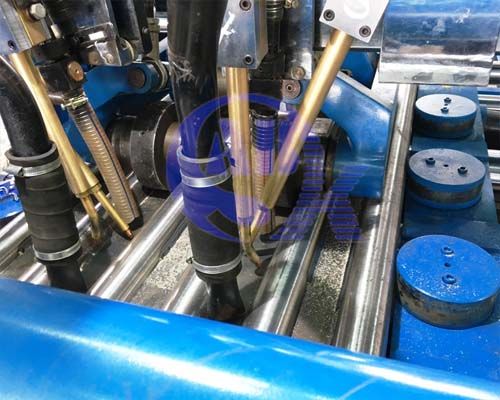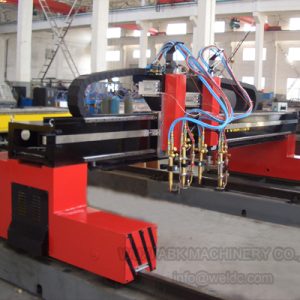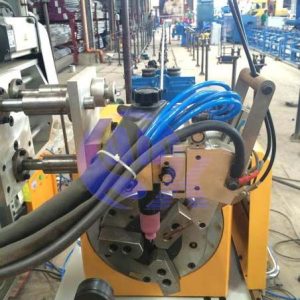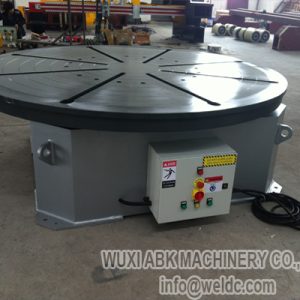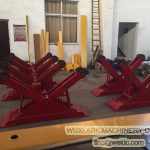Membrane Panel Welding Machine
The standard membrane panel welder is designed to a width of 1600mm operating with 4 welding torches utilising submerged arc welding (SAW) technology. This is the most commonly ordered specification for good reasons:
– High productivity/efficiency in fabrication
– Panel products within transportation limits
– Practical and stable application
– Lower cost of machine and meeting sufficiency
We may however custom built to the customer’s requirement (owing to technical limitations). Our experiences span from panel welders with varying widths, number of welding heads , SAW or MIG/MAG or both utilizing your preferred power sources.
Forging Excellence, Welding Solutions!
- E-mail:eric@weldc.com
- WA :+86 150 0619 3977
- YouTube :https://www.youtube.com/@ericxu1146
Description
ABK continues today to innovate and adopt newer technology in achieving user friendliness with the introduction of digital touch screen panels. The panel welder will greatly increase outputs and reduce overheads with just 1 operator.
Since 2008, we have actively exported our equipment to countries such as India, USA, Russia, Philippines, Malaysia , UAE and Indonesia. Not forgetting our customers (both foreign and local) numbering over 100 operating in China whom we have serviced since 1996.
Comparison Table between SAW and MIG/MAG we hope would help you better decide on your investment
| 2X SAW 4 torch membrane panel welding machine | 1X MIG/MAG 12 torch membrane panel welding machine | |
| Weld penetration | Deep, 3 – 5mm | Shallow, 1 – 1.5mm |
| PPE | No light pollution operator assumes basic PPE |
Intense light pollution Welding mask Protective clothing |
| Weld quality | Good weld presentation Minimal rework |
Average weld presentation, often porosity, spatter, undercut Requires rework |
| Welding consumables | Flux, can be recycled | Inert gas, gas not recycled |
| Left over | Welding slag | None, balance gas evaporates |
| Process | One side welded during a single pass | Both top and bottom side welded during a single pass |
| Productivity | 0.8 – 1.5m/min | 0.5 – 0.7m/min |
| Manpower | Easy to operate, one operator required for 4 torches | Requires experienced welder |
| Welding dies | Minimal amount of welding dies, dies replaced when fin bar size or centering height changes | High volume of welding dies. Different tube diameter or different fin bar size requires change of dies. Large effort in replacing dies. |
| Cost of welding dies | Low cost, estimated at USD500.00 | High cost, estimated at USD20,000.00 |
| Acceptance | Accepted by all | Used only with allowed fabrication process, typically in small/low pressure applications within limited regions in the world |
| Case study | 2 X 4 torch SAW panel welding machine Welding speed: 1.1m/min Production quantity: 8.8m/min |
12 torch MIG/MAG panel welding machine Welding speed: 0.6m/min Productivity: 7.2m/min |
Overview of Specification
| Tube Diameter | 22-89mm |
| Tube Wall Thickness | 3-10mm |
| Width of Fin-bar | 8-120mm |
| Thickness of Fin-bar | 3-12mm |
| Welding Width | 1600mm |
| Welding Speed. | 0.5-3m/min |
| Welding Wire Diameter | 1.6-2.0mm |
| Wire Feed Speed | 1-10m/min |
| Wire Tray | 4 units (each with 150Kg capacity) |
| Compressed Air Requirement | 6kg/cm2 |
| Welding Head | 4 |
| Installed Power. (with 4 welding heads) | approx. 280KW |
Membrane Panel Welding System
A basic membrane panel production line consists of 4 basic equipment. They are:
– Membrane panel welding machine
– Fin bar calibration machine
– Tube polishing machine
– Panel bending machine
Introduction

1) The first steps are i) Tubes are protected against rust and corrosion by a protective layer, this prohibits welding and requires them to be “cleaned” by either polishing or sand blasting. ii) Fin bars are required to be calibrated or sized to attain the desired consistency in a panel’s final dimension.
2) The polished tube and fin bar then enters the panel welding machine to be joint by welding.
An example of the typical sequence of welding a 10 tubes membrane panel.
i) Pairs are joint and accummulated. It’s essential to note: a) Always maximize the 4 torches when possible for maximum efficiency. b) To minimize the change in machine setting.
Step One
– Pairs are joint in this manner O–OO–O utilizing all 4 torches of the welder
– Accummucate multiples of O-O
Step Two
– With the completed pairs O-O, take 3 pairs and joint in becoming 6 as seen here O-O–O-O–O-O still utilizing all 4 torches of the welder
Step Three
– With the completed 6 tubes panel O-O-O-O-O-O, joint to it 2 completed pairs from step one. Still, we are utilizing all 4 torches of the welder
– O-O–O-O-O-O-O-O–O-O We now have a 10 tubes panel.
You should always remember!!! To avoid distortion, it’s important to maintain a balanced heat input. To achieve this, firstly we maintain all 4 torches to have an equal input current and voltage setting, secondly we always weld at a position that’s equal distance apart.
8 Tubes panel
You are probably asking about a 8 tube panel. So here’s how we would do it.
Complete Step one and Step two of the above instruction.
What’s different is (Remember equal distance apart), now for Step three of a 8 tube panel.
Here we have it O–O-O-O-O-O-O–O, instead of a pair from Step one, we placed a single tube and fin bar onto both the outer ends of the 6 tubes panel.
Design of membrane panel production line
The question is how much do you need to produce? From experience, a single panel welder machine with 4 torches could run over 1000 meters of weld on an 8 hour shift. A new user could find themselves acheving only 500 meters, and this number grows as the operator gains confidence over time.
Big boiler manufacturers could have up to 10 membrane panel welding machines.
So back to you, how much work do you have? Contact us for a solution.
How do we position a fin bar during the welding process
This is a question I get a lot, let us discuss this a little.
There are mainly 2 methods commonly seen or used in the industry. Please refer to the picture below:
Method 1

There are typically 2 sets of the above dies/mould installed at the front and back to hold into position the tube and fin bar. This would place the fin bar in the exact desired position during the welding process. However, every change of tube diameter, fin bar width, fin bar thickness would require an extensive replacement/change of the dies. This can be a tideous and time consuming process, often very expensive. Perhaps for manufacturers of a fixed design, without any custom orders or design changes could they not be required to change such dies.
Method 2

This is our way. The parts in yellow are dies and can be removed and replaced. The fin bar is supported into position by 2 sets of wheels at the bottom, and a ring on the top.
– The bottom rectangular piece (a shim plate- in yellow) adjusts the desired height to bring the fin bar into
the correct position from the bottom.
– The top ring (in yellow) slides into the roller clamp, can be easily obtained by machining. It positions the fin bar from the top.
– The bottom roller wheel (in yellow) changes when there is change in fin bar width.
You can afford to have different sizes in store, catering to different tube diameters, fin bar width and thickness. A complete set would cost just a few hundred dollars.
Established in 1999, Wuxi ABK Machinery Co.Ltd is a professional manufacturer of welding positioner in China. Apart from welding positioner, we still have many other high-quality products, such as welding rotator, welding turnable, wind tower production line, H beam welding line, pipe welding equipment, CNC cutting machine, grinding machine, roll forming machine, plate bending machine, etc. With ISO and CE certification, our products are quite popular among clients from Spain, India, Germany, South Africa, Brazil, Chile, Argentina, Russia, Italy, France, Vietnam, and more. If you need welding positioner, please contact us freely.

